Satara Municipal Corporation
This project aimed to develop an architectural expression that harmonized its surroundings with the built form over time, not only in terms of architectural language but also of spatial quality.
Inspired by the Courtyard typology of the traditional building “The Wada’s” from Satara, the building was devised as a courtyard-type, introverted plan.
A language of solidity and transparency was juxtaposed to capture the soul and purpose of this building, delicately balancing strength and fragility. Inspired by the nature of modern-day corporate offices, the idea was to create TRANSPARENCY in spaces which shall in turn create transparency in the way of working; this openness in the spaces would improve the overall efficiency in working.
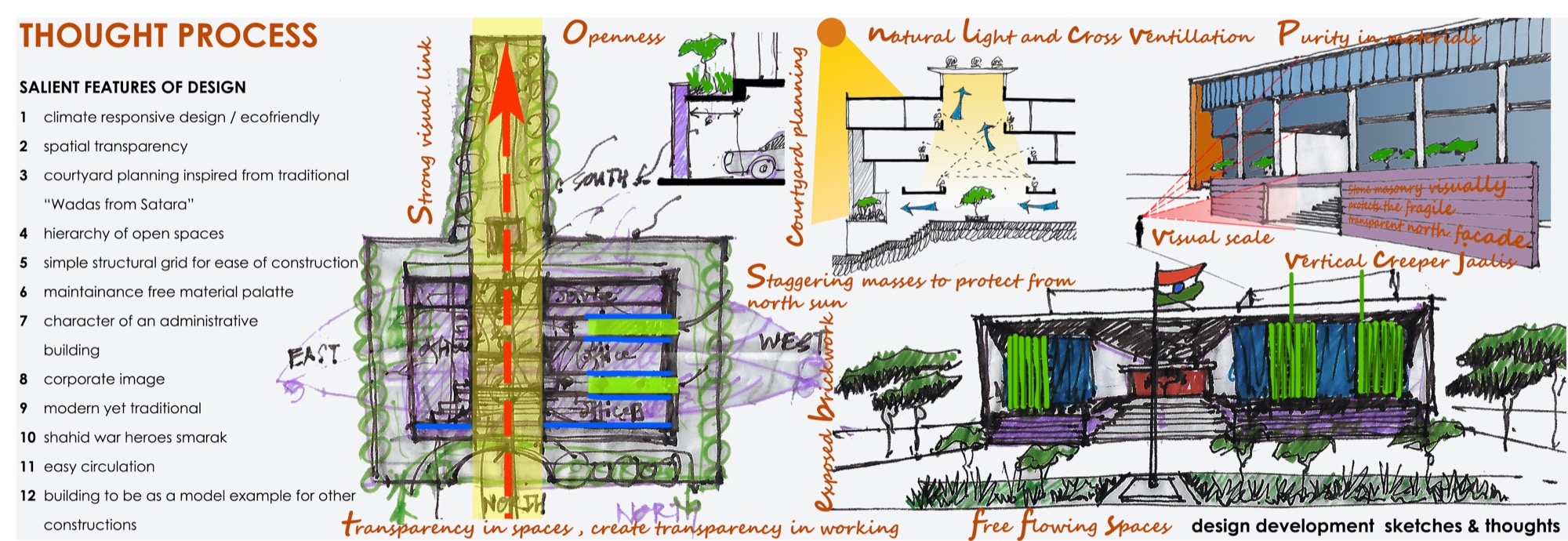
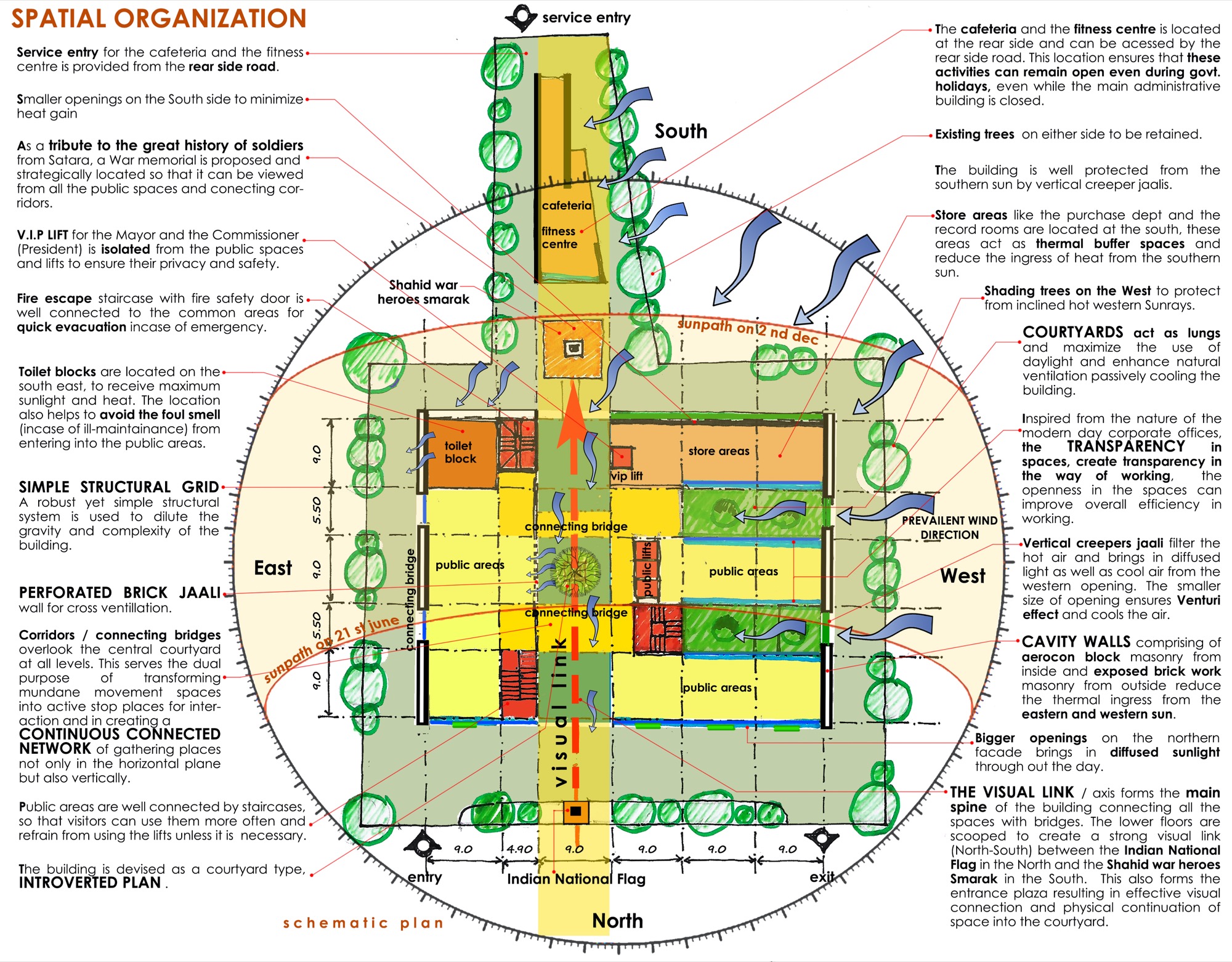


A strong fortified wall in Black basalt Khandki (local stone) stone masonry, resembling its connection to the roots of the traditional Wada’s, welcomed the visitors. This Stonewall also signified strength and protected the fragile transparent image of the building.
While the project was square and firm on the ground, it subtly opened through the lower floors. A strong visual link/axis connected the Indian National flag on the North and terminated at the Shahid War Heroes Smarak in the South. The entrance plaza resulted in an effective visual connection and physical continuation of space into the courtyard.
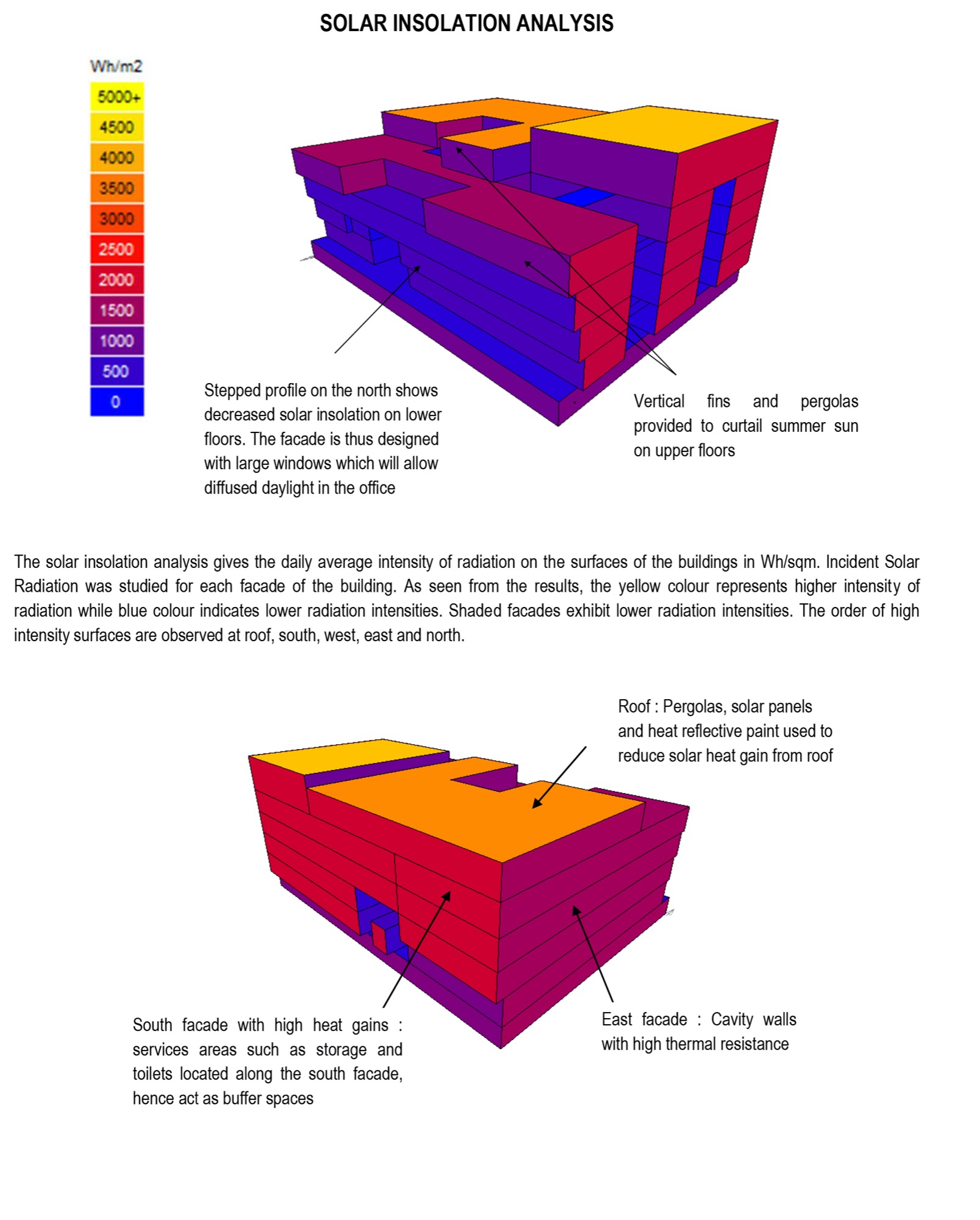
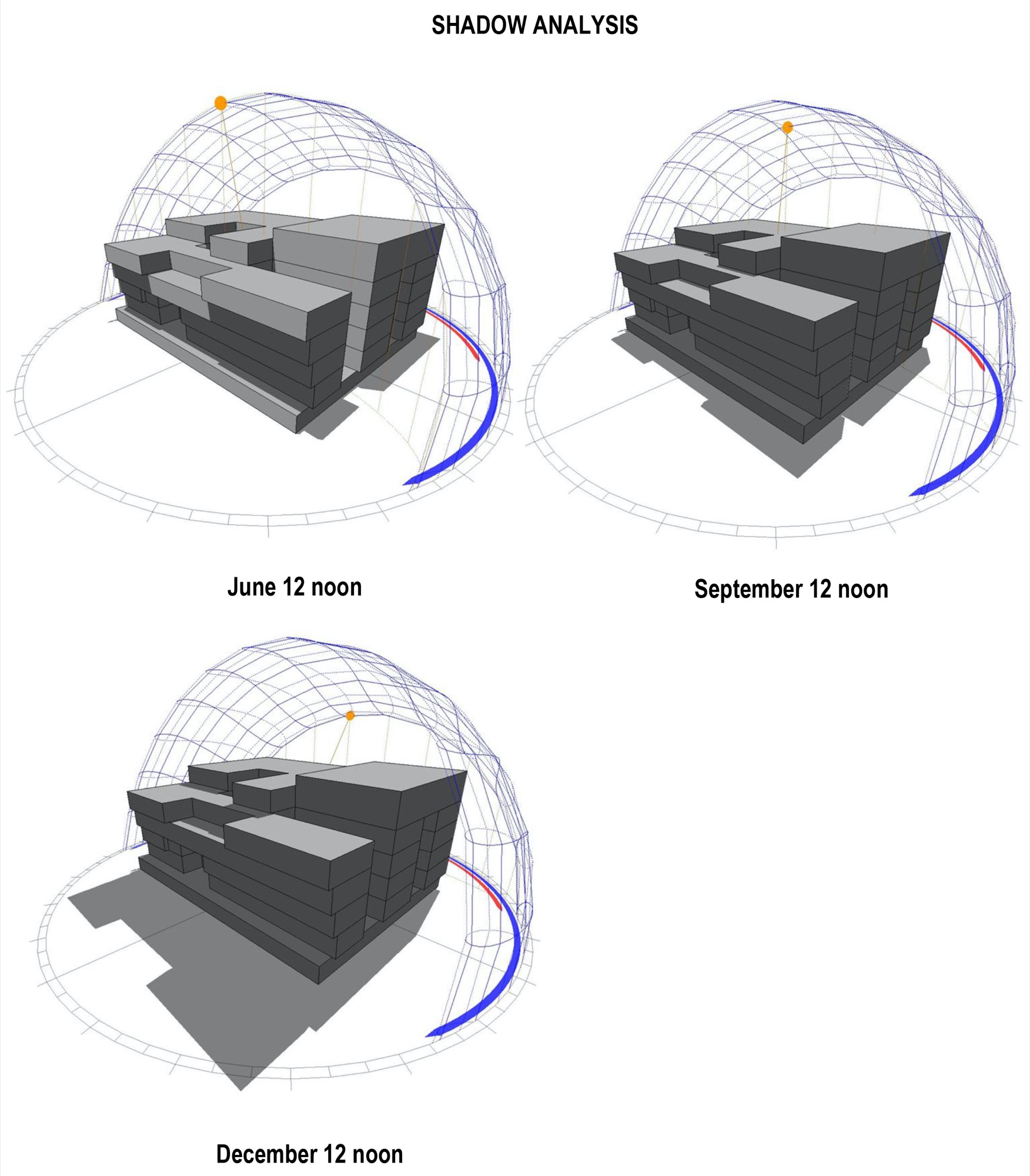
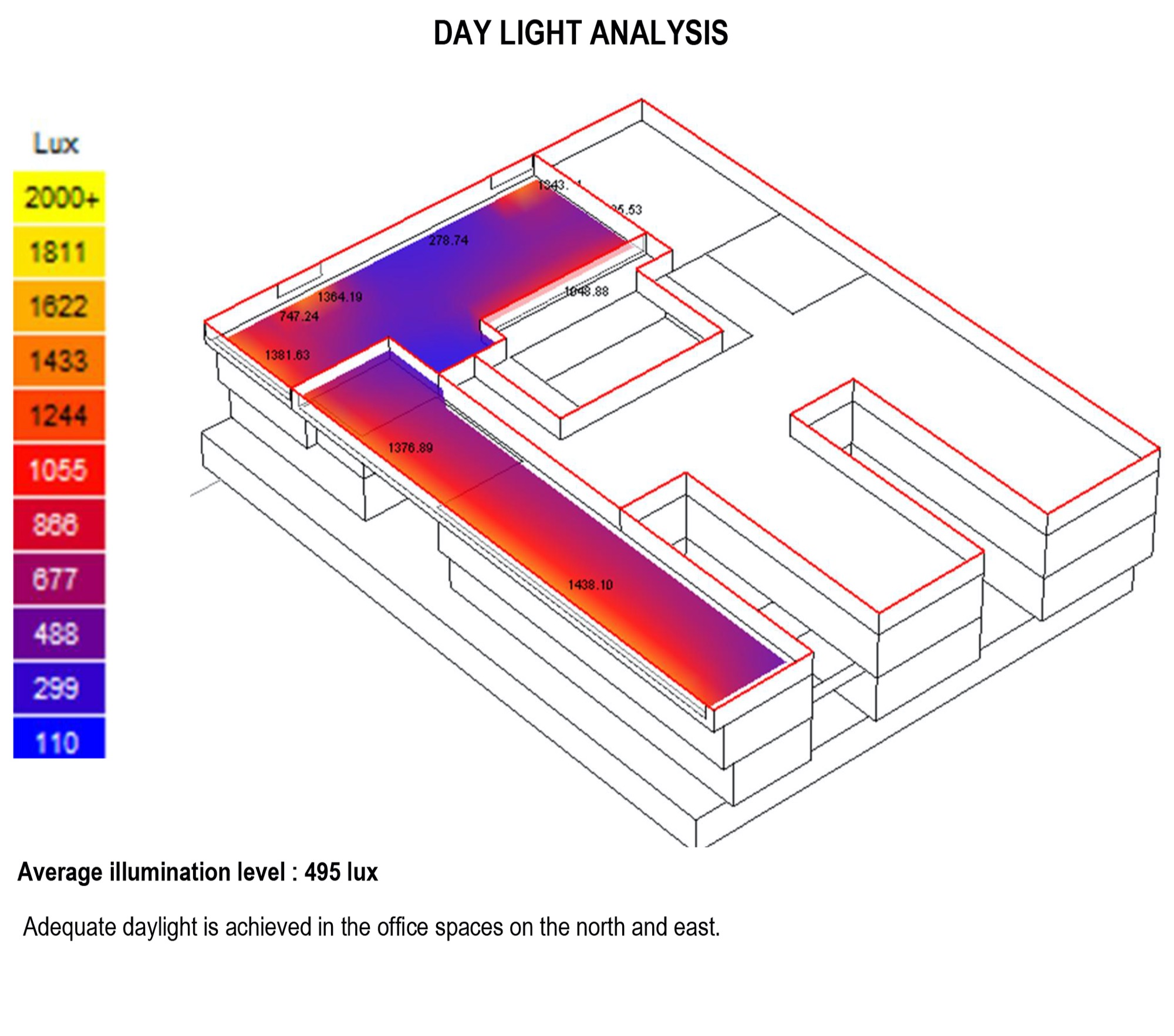
The building houses two parking floors (basement and stilt floors), three floors for public offices (first, second and third floors) and two V.I.P floors (fourth and fifth floors). As one moved inside, the space transcended into the central atrium/courtyard. The spaces gradually started unfolding their true nature and their relations with the different office departments.
The idea was to create a public space that flowed at many levels. Corridors/connecting bridges overlooked the central courtyard at all levels. This served the dual purpose of transforming mundane movement spaces into active stop places for interaction and creating a continuously connected network of gathering places not only in the horizontal plane but also vertically.
The courtyards acted as lungs, maximizing the use of natural daylight and enhancing natural ventilation passively cooling the building. Natural light reduces the need for artificial lighting. The Skylight above the courtyard is well-ventilated with evacuator fans, which extract the trapped hot air. The orientation and placement of the smaller courtyards responded to the solar angle such that generous mixes of shaded and sunny spaces were produced to be equally comfortable in summer and in winter.
To cut down heat absorption substantially from the east and the west, cavity walls made up of Aerocon block masonry from the inside and exposed brickwork from the outside were proposed, with vertical creeper jaalis on the openings to bring in cool filtered air inside the building.
A robust yet simple structural system was used to dilute the complexity of the purpose of the building and also make the construction economical.









The materiality reinforced the duality in time – aspirations of a developing nation with roots ingrained deep in a rich cultural past. The building boldly displays a mix of local stone, exposed bricks and concrete which is maintenance-free. The materials were carefully selected considering the climatic needs of the region while retaining the progressive design intent and their ability to age gracefully.
Satara is known for soldiers who laid down their lives to fight for our country. As a tribute to the great history of soldiers from Satara, a War memorial was proposed and strategically located so that it could be viewed from all the public spaces and connecting corridors. Inspired by the “Char Bhinti Smarak” in Satara, the Shahid War Heroes Memorial pointed upwards towards the heavenly sky, signifying their ultimate sacrifice.
The cafeteria and the fitness Centre were located at the rear side and could be accessed by the rear side road. This location ensured that these activities remained open even during govt. holidays, while the main administrative building was closed.
The roof of the main building could have around 300 nos: of photo voltaic panels and could generate electricity catering up to 20% of the electrical needs for the whole building.
The approach was to address the core needs of any public building i.e. user-friendly spaces, maintenance-free material palette and climate-responsive architecture by making maximum use of natural light and ventilation and creating a HUMBLE yet PROMINENT Icon for Satara City.
Drawings and Details
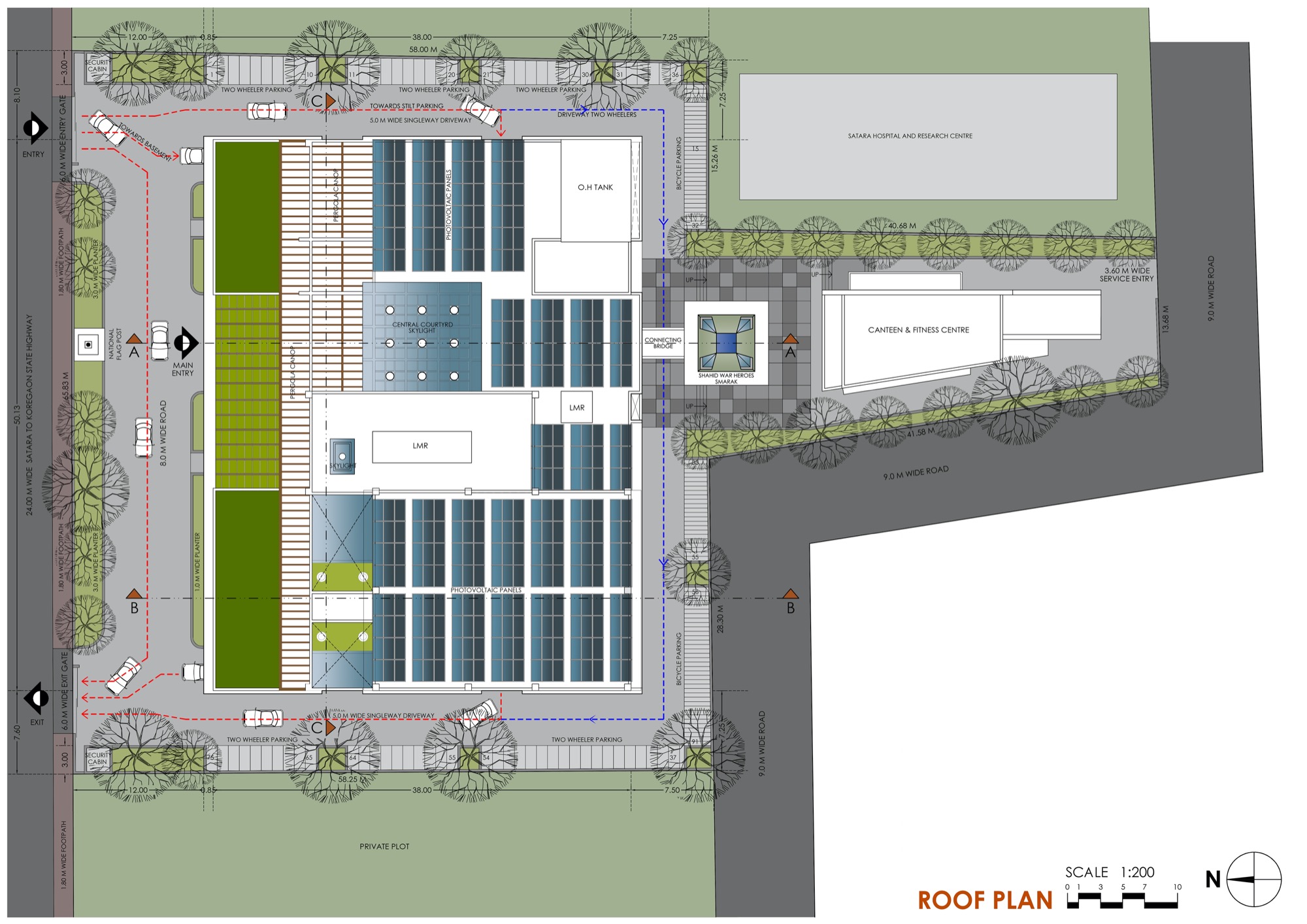
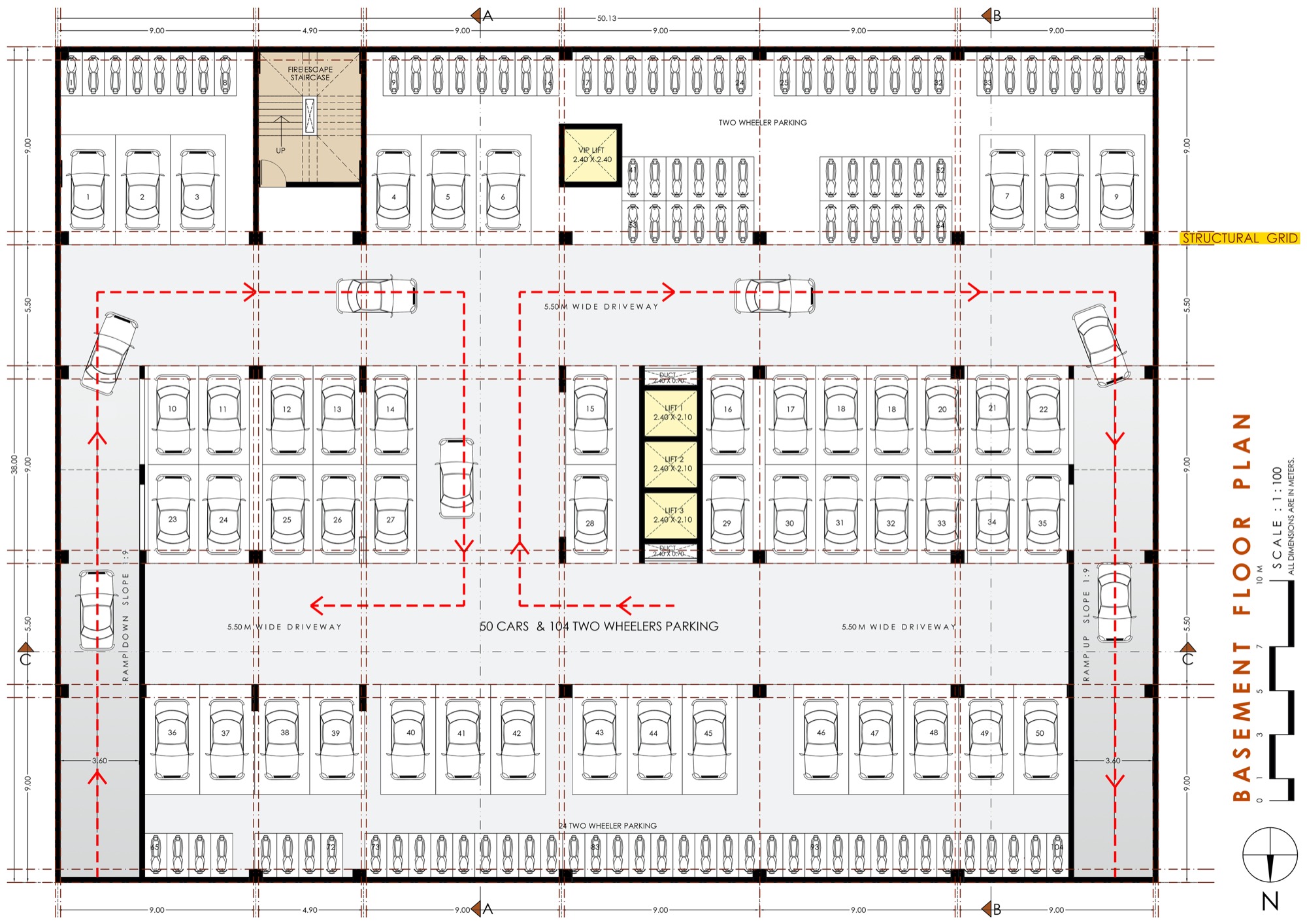
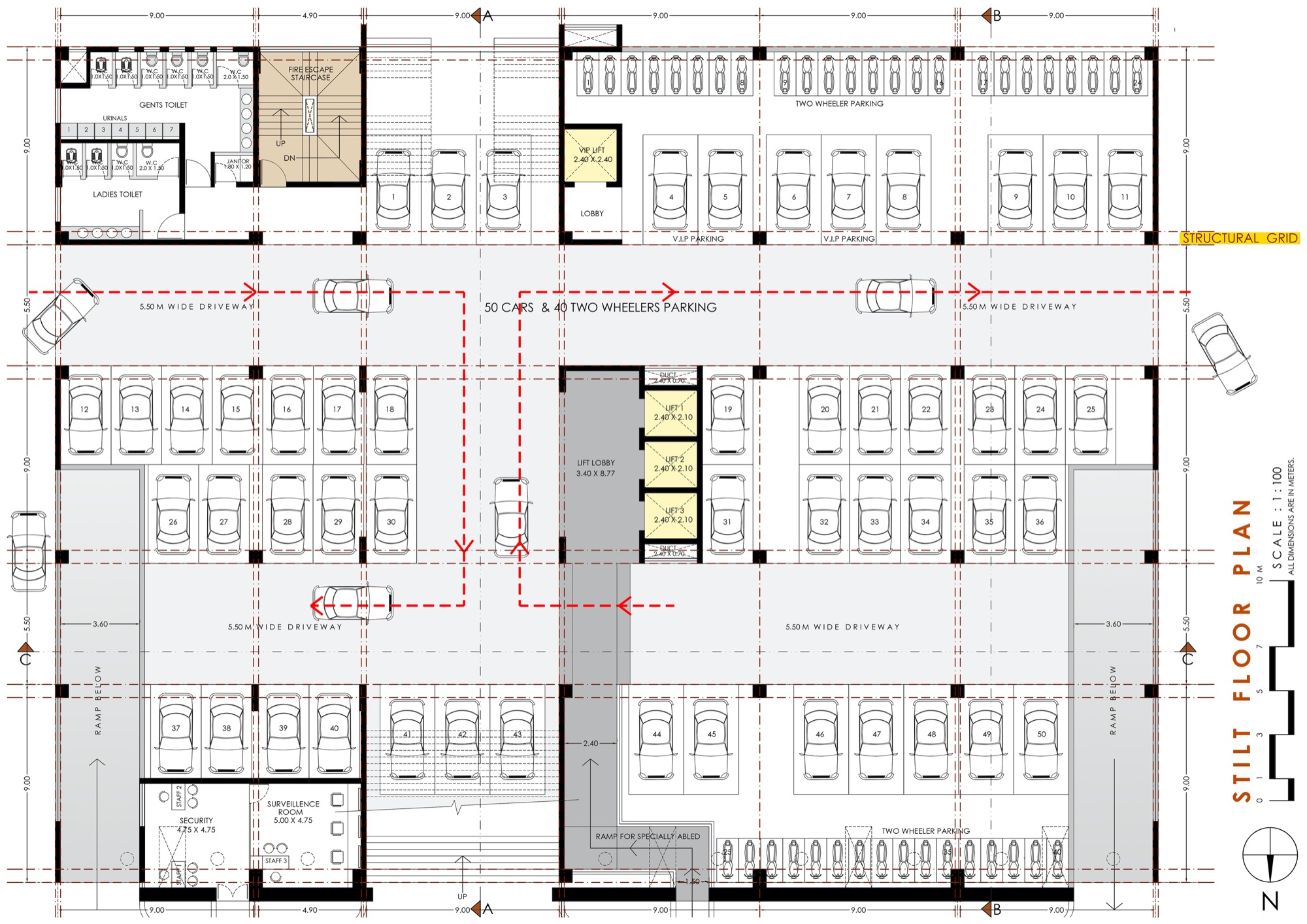
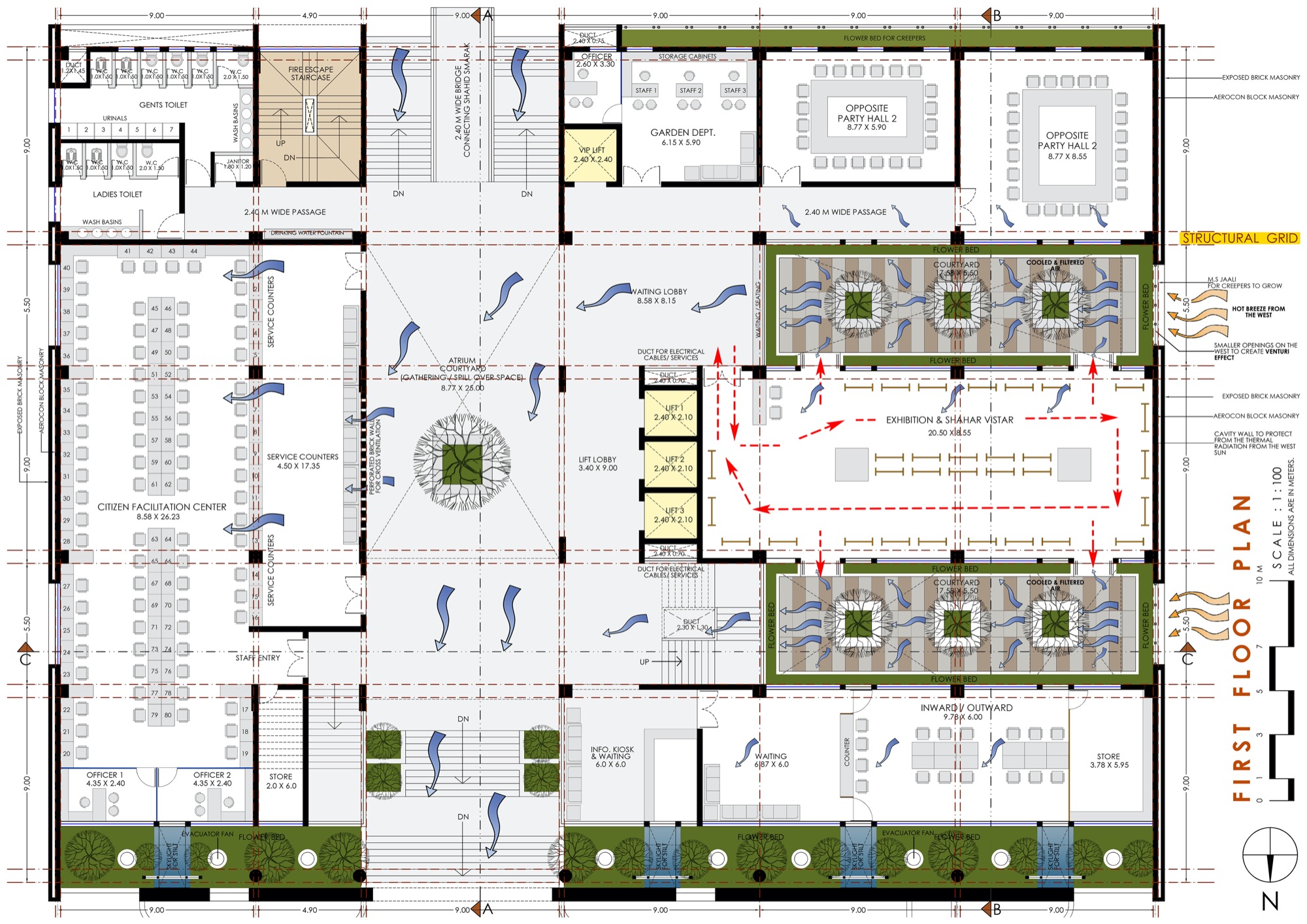
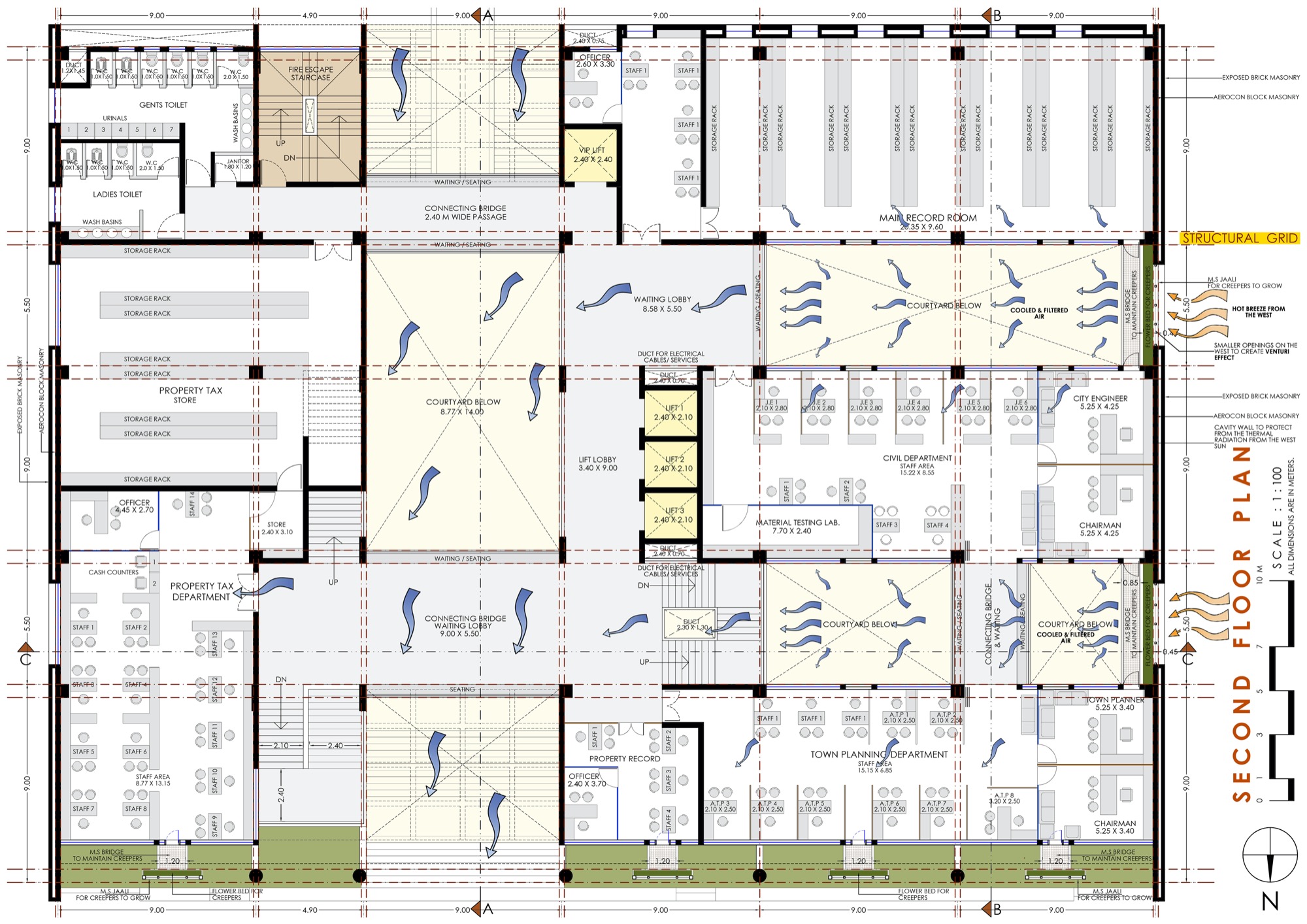
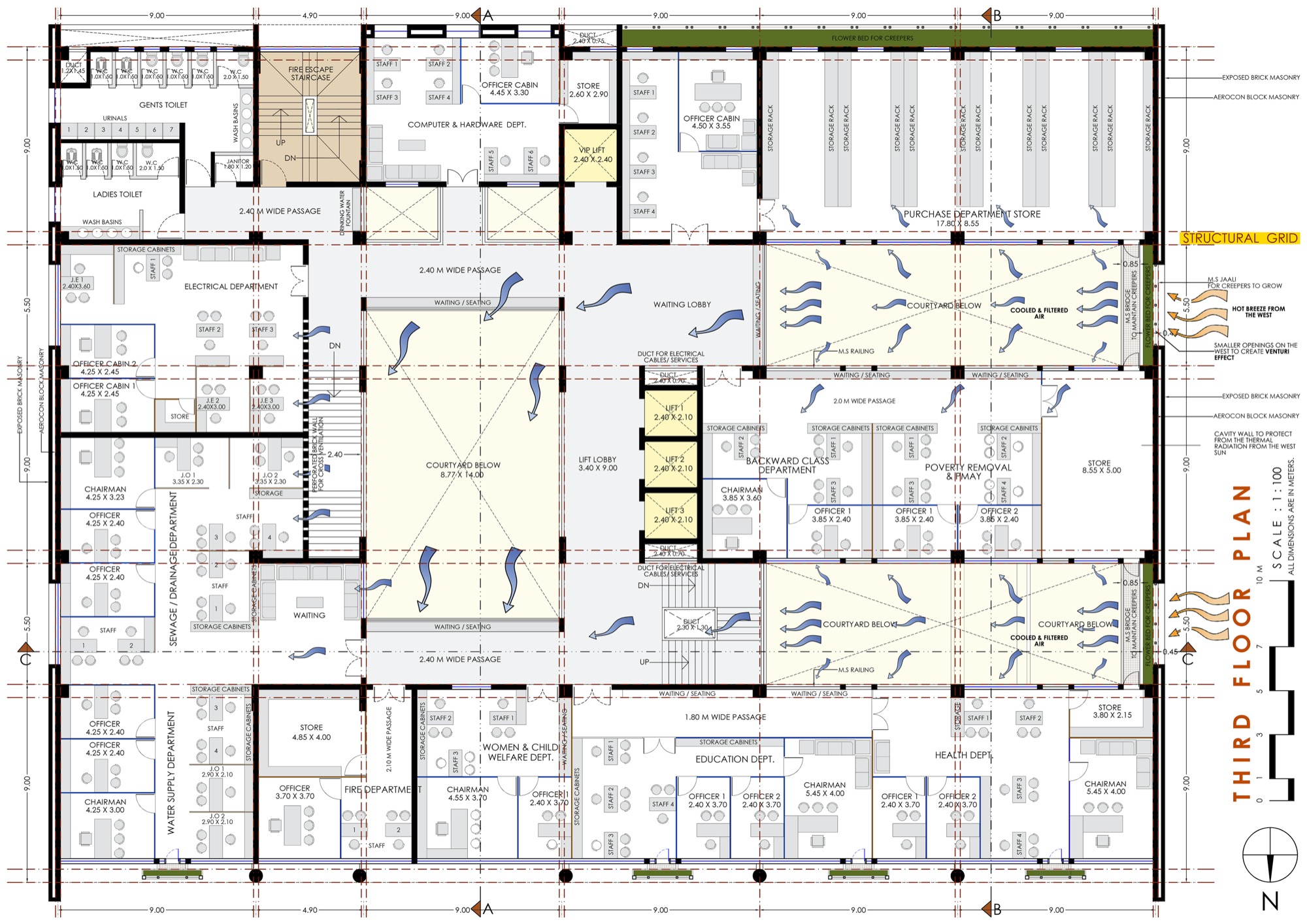
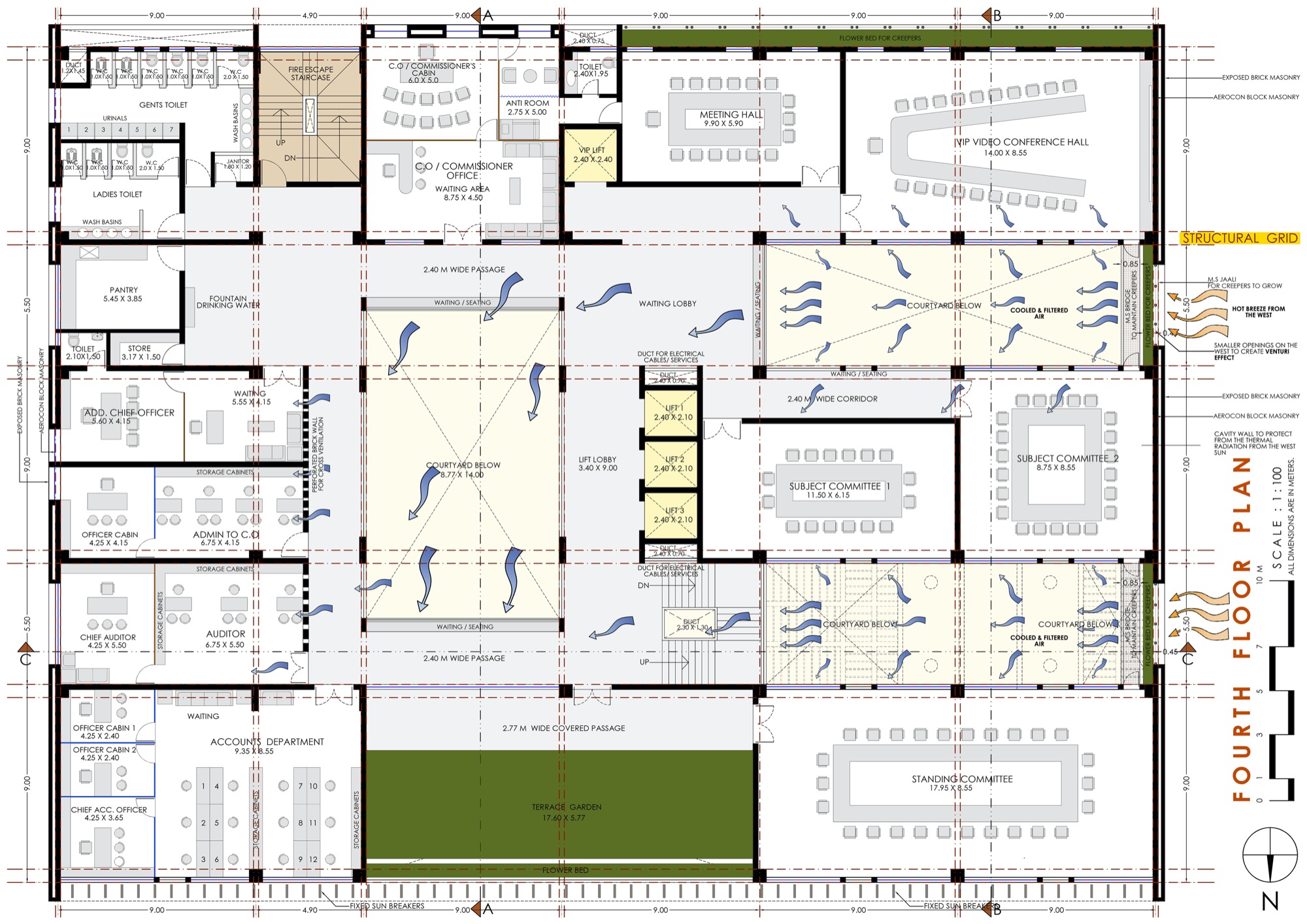
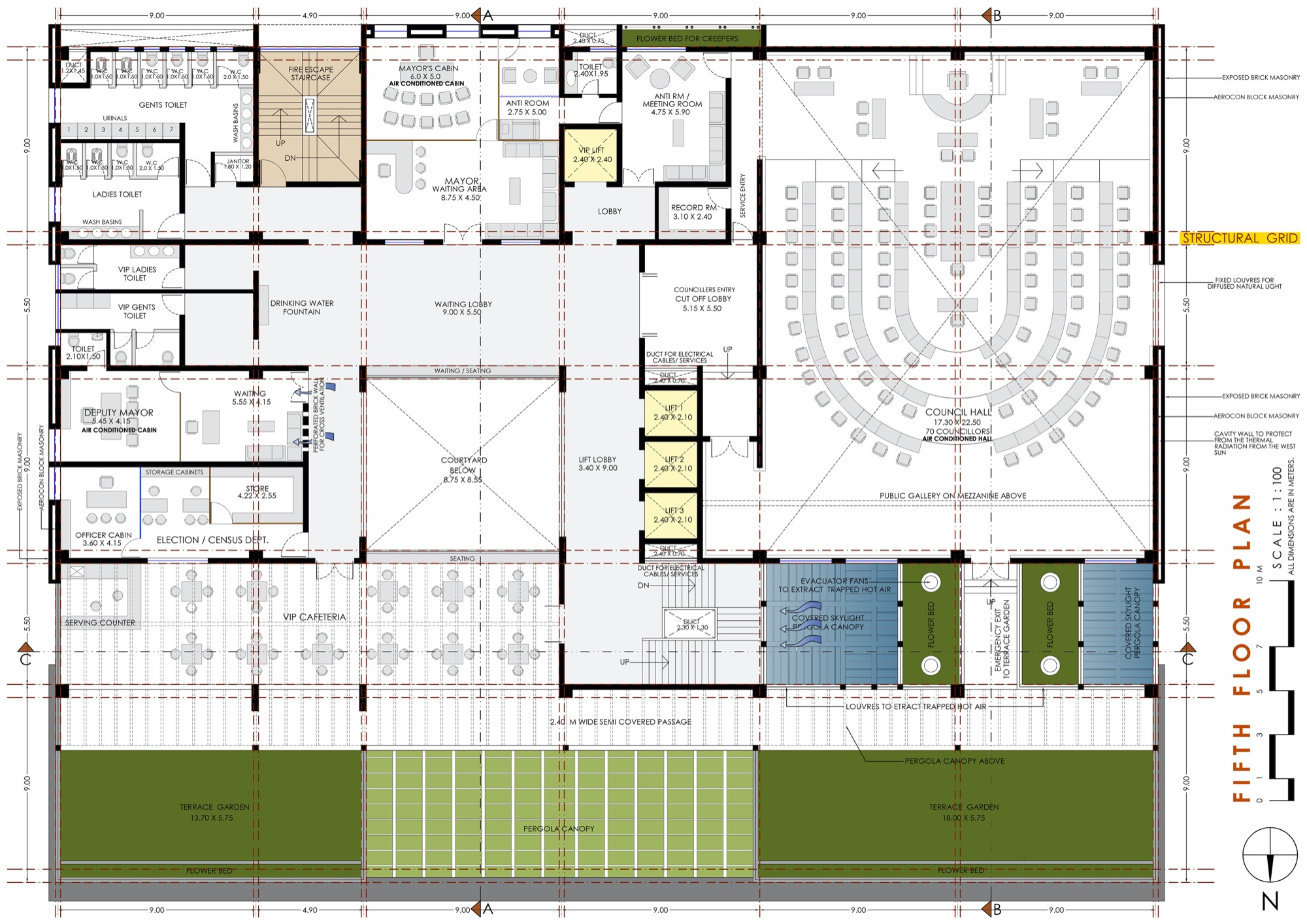
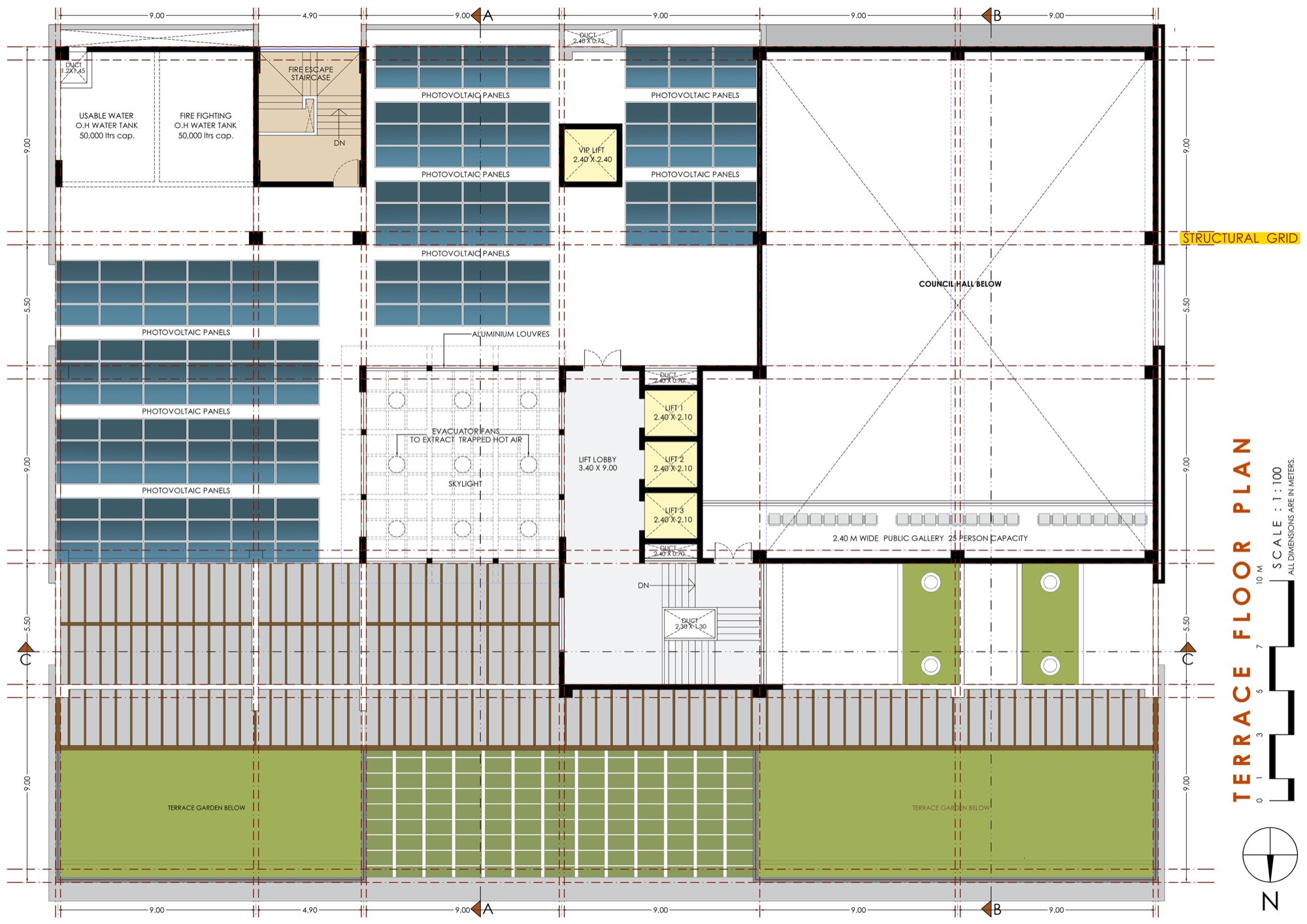
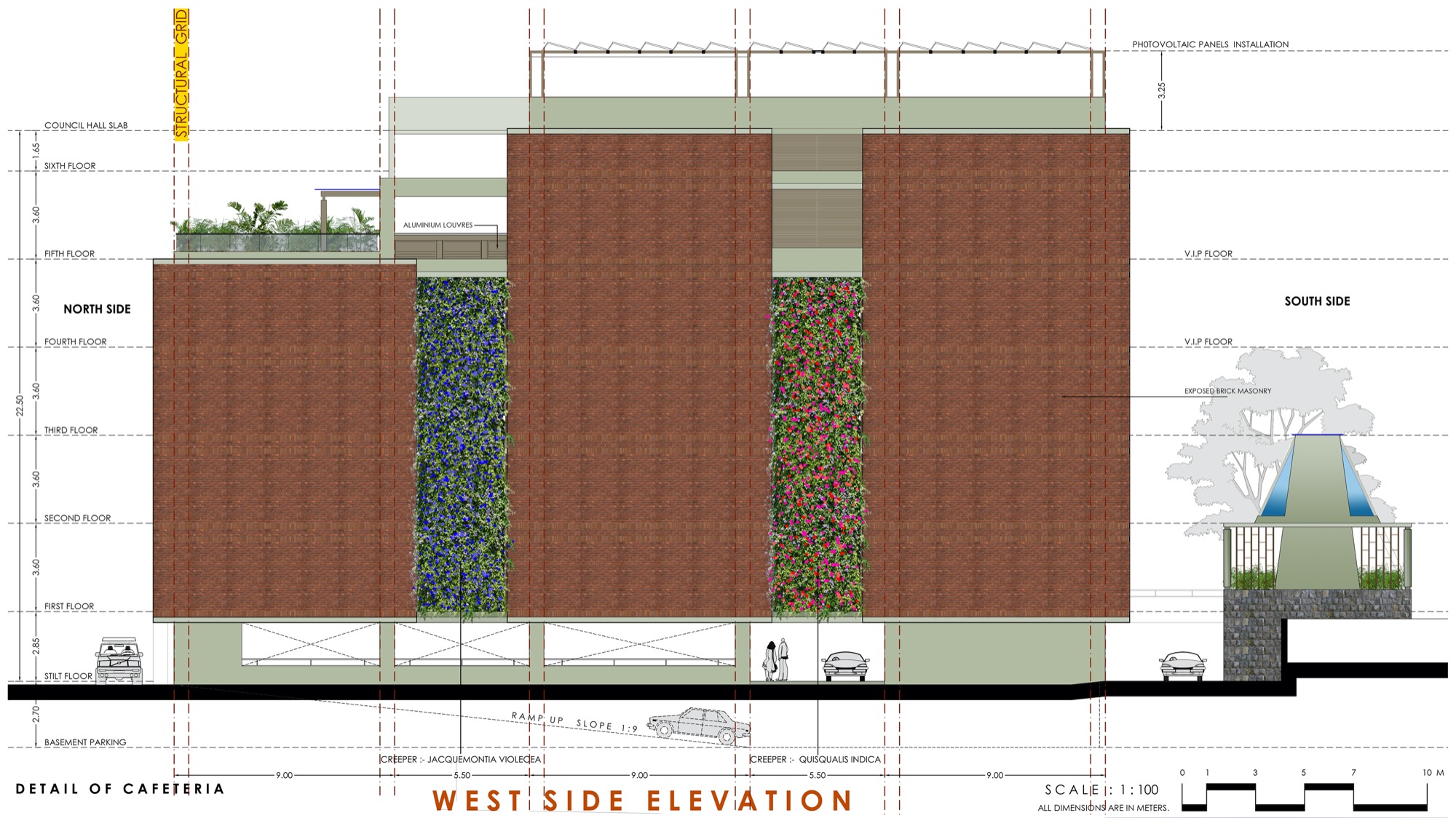

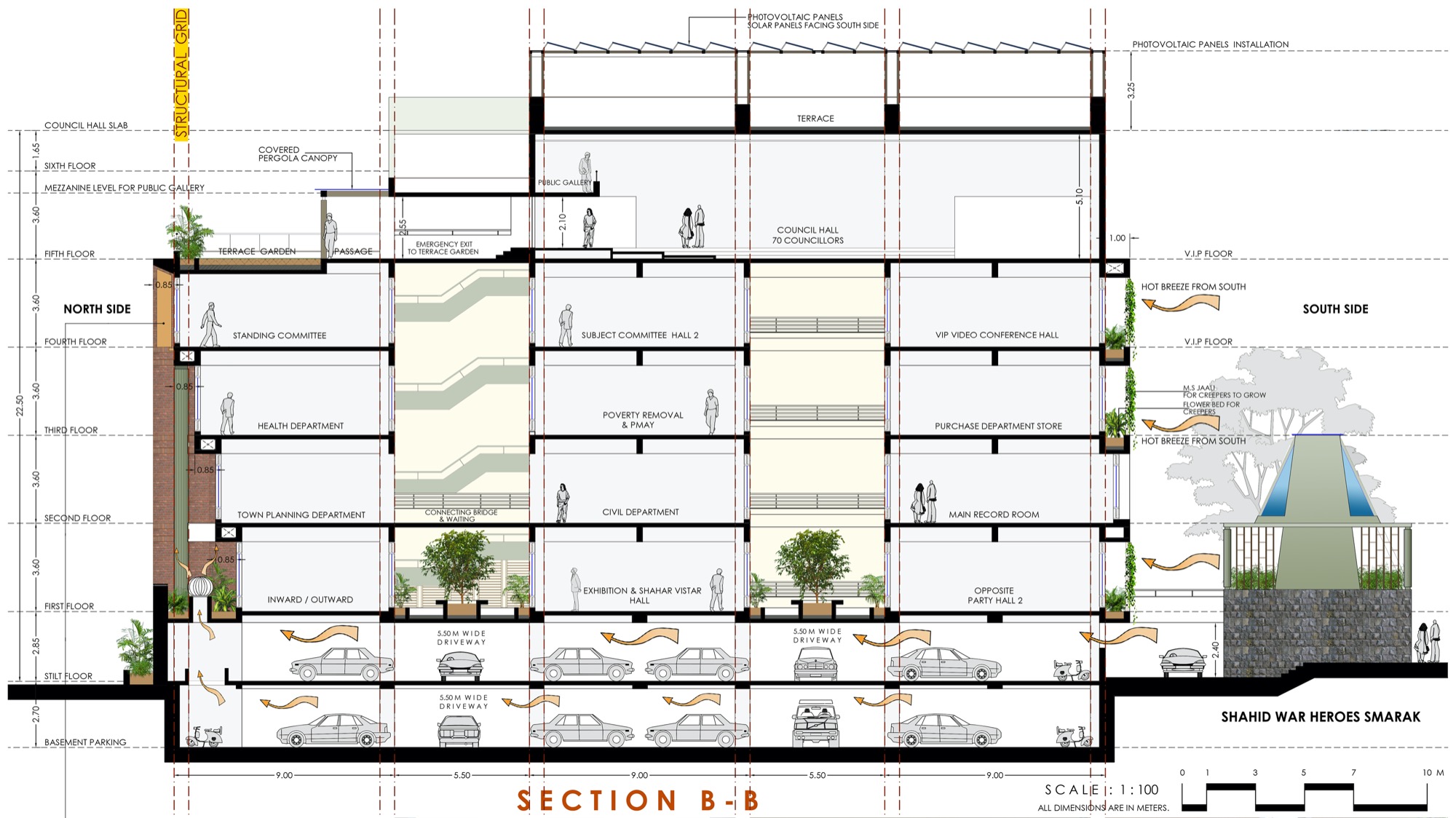
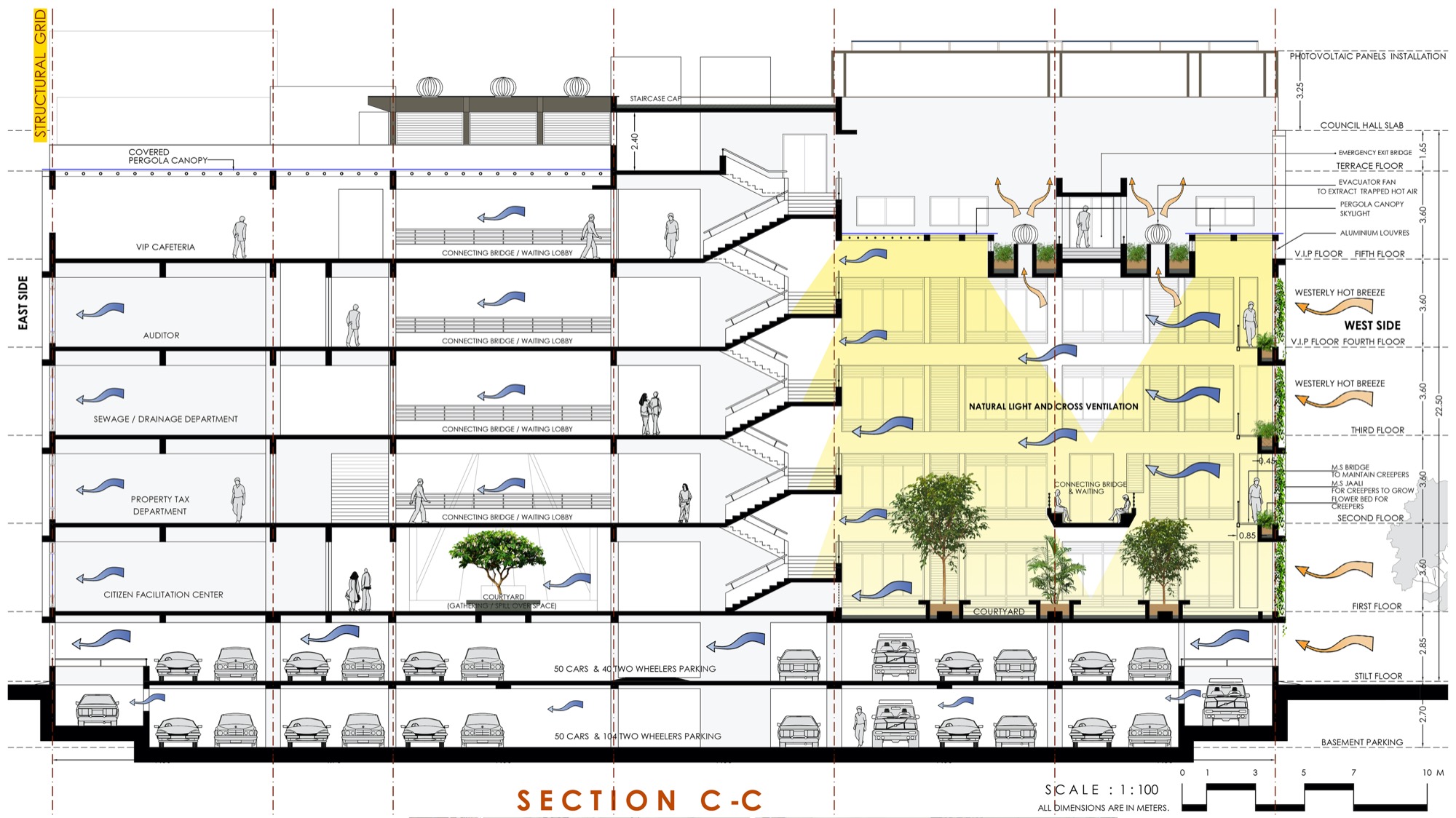
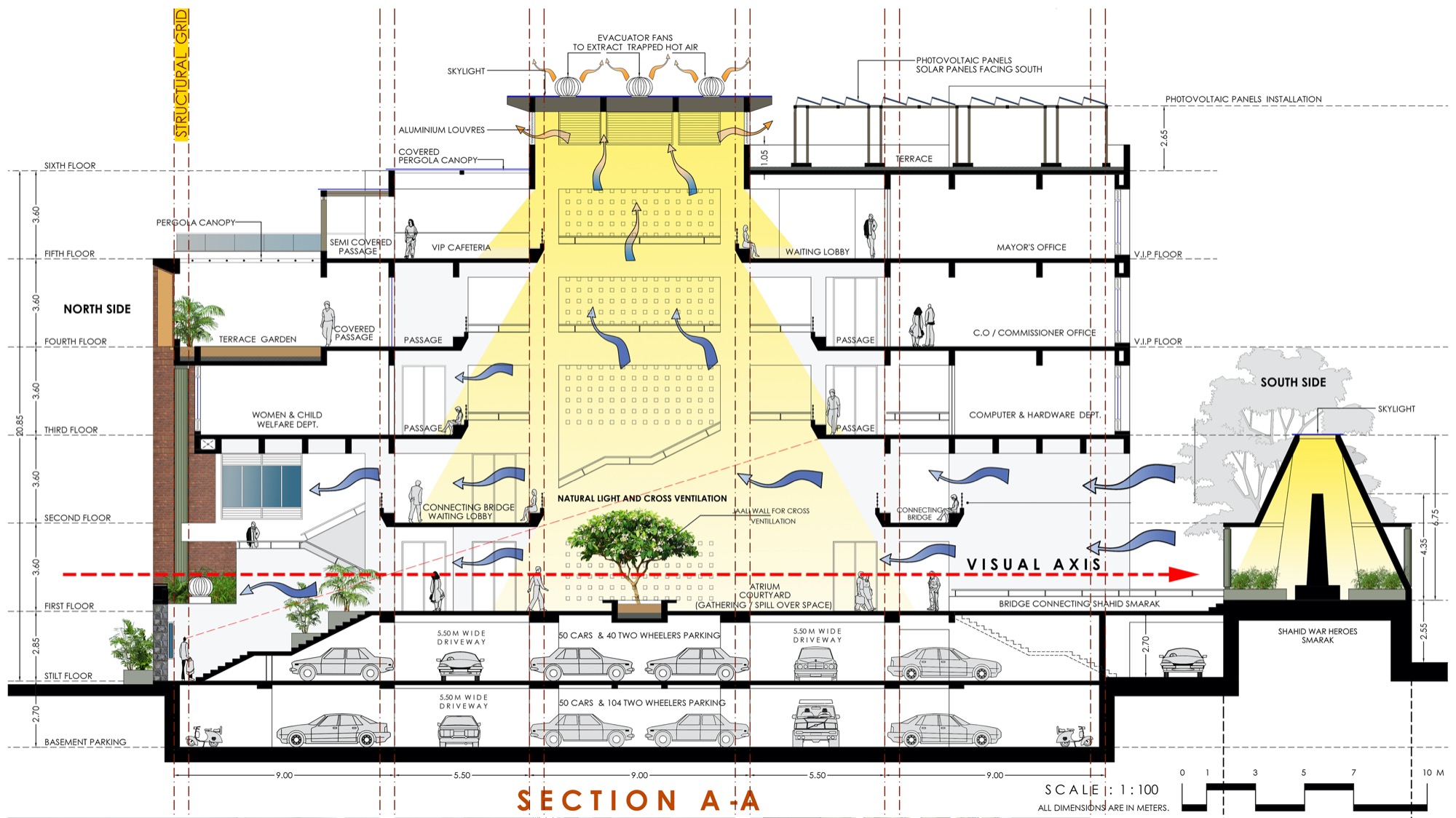
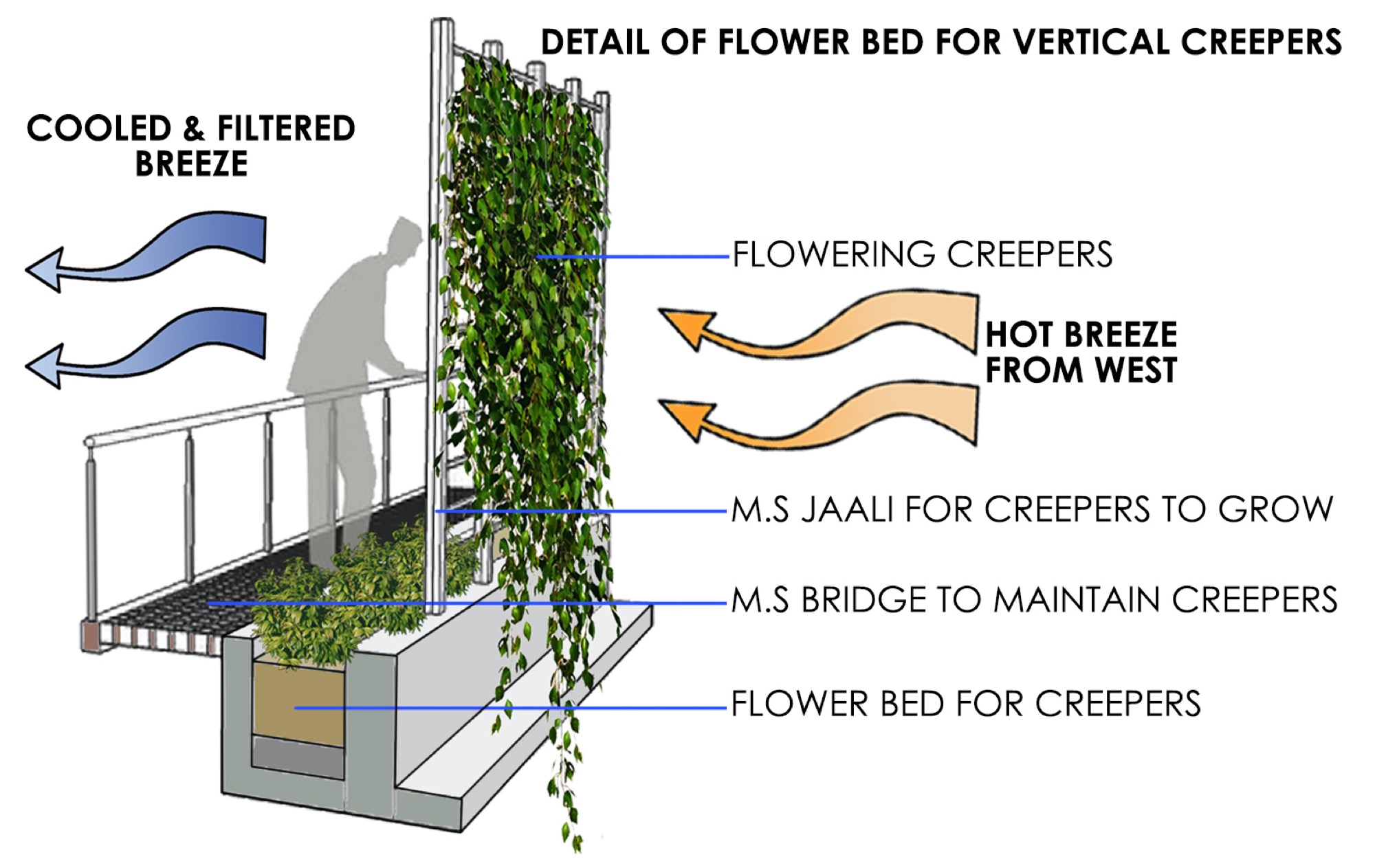
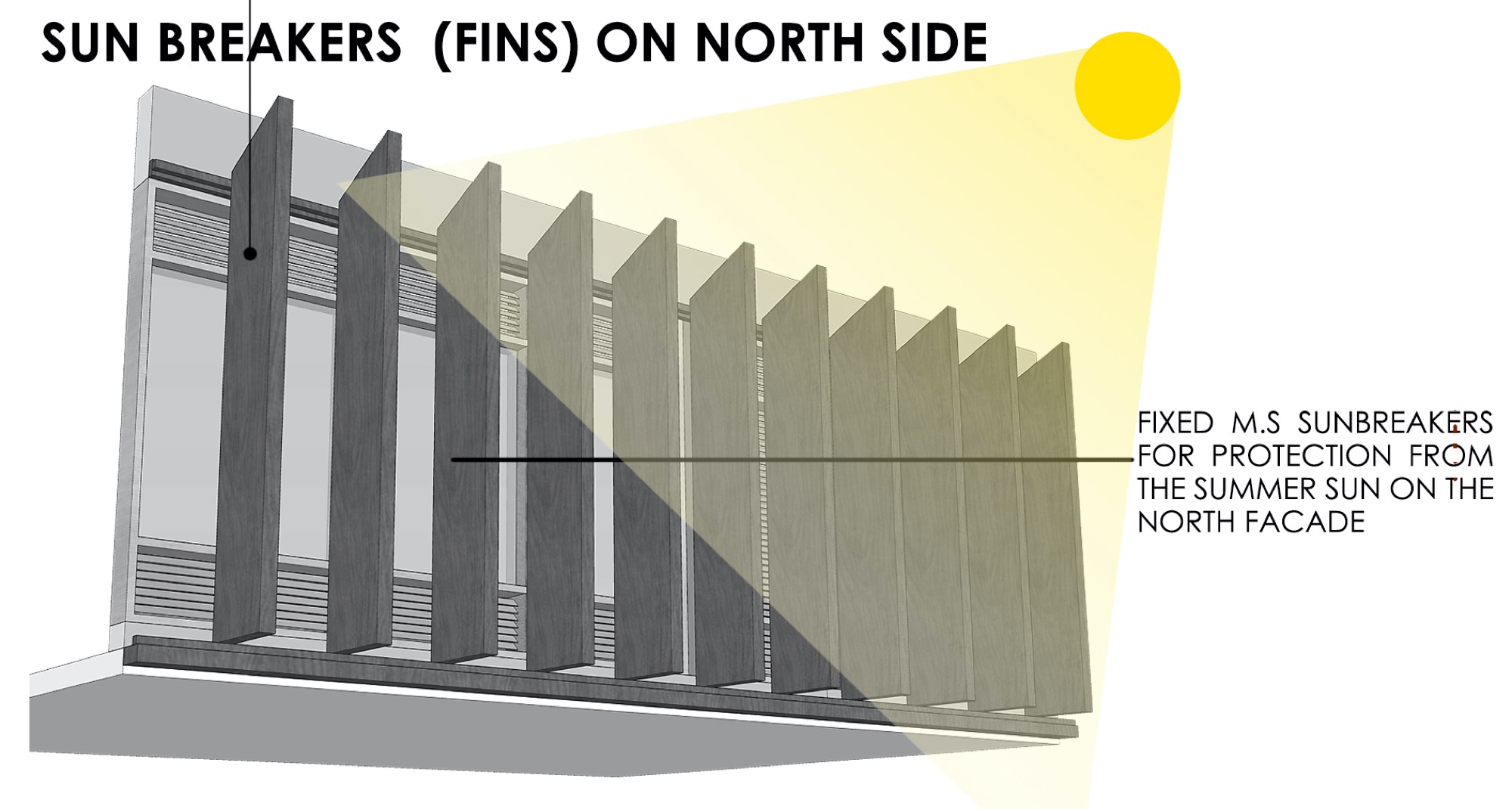
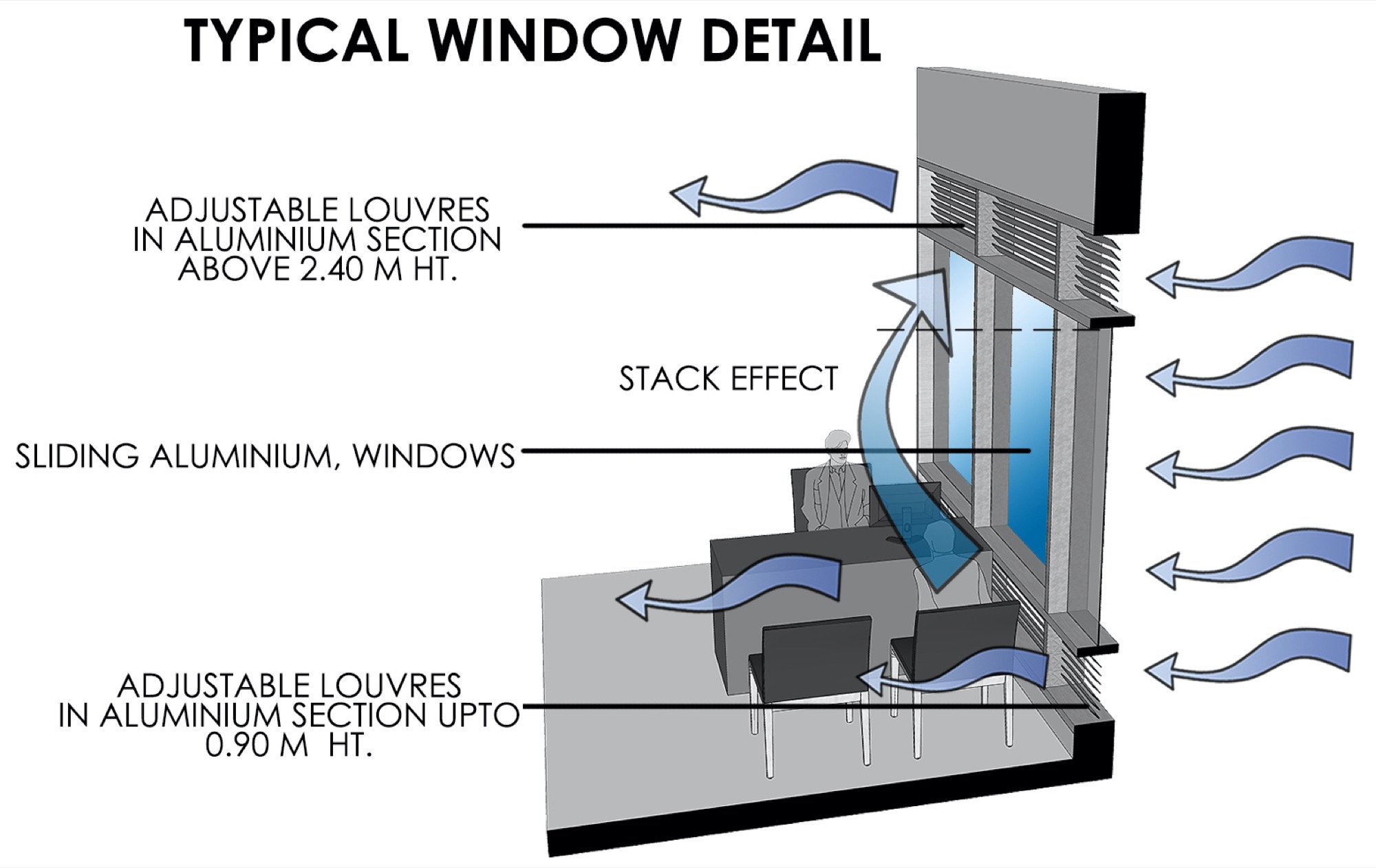
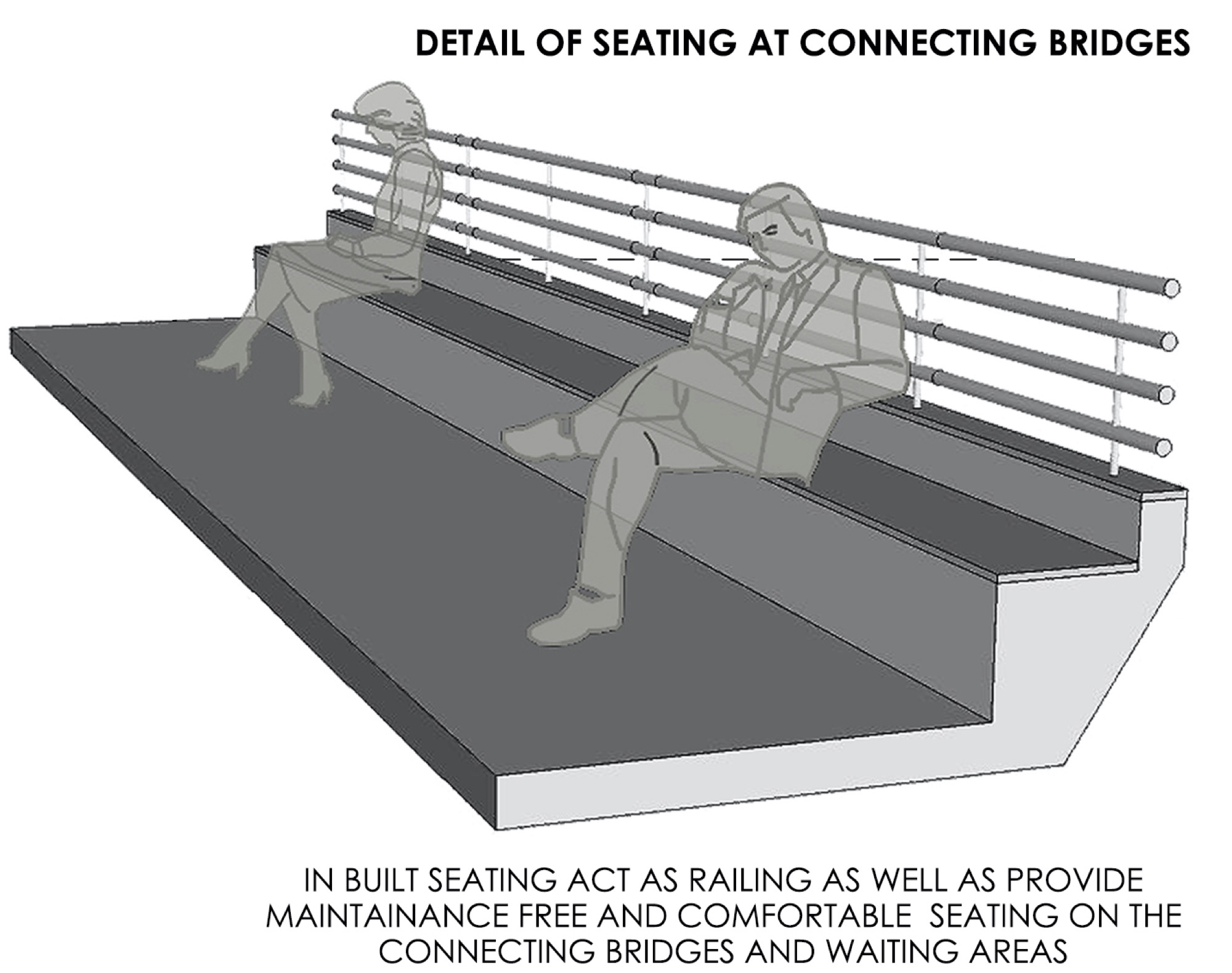
Climate Response:-
- Cavity walls comprising of Aerocon block masonry from the inside and exposed brick work masonry from the outside reduced the thermal ingress of the inclined sun angle from the East and the West.
- Vertical creeper jaalis filtered the hot air and brought in diffused light as well as cool air from the Western openings. The smaller size of openings ensured the Venturi effect and cooled the air.
- The flowering creepers on the building façade were selected as per the availability of the sun, these creepers served the dual purpose of shading the building as well as signifying its relation with the flowering Kaas Pathar, which also formed the important identity of the Satara region.
- Bigger openings on the Northern façade would bring diffuse light into the office areas throughout the day. Staggered massing of the North façade, shades the summer sun during Uttarayan.
- Courtyards acted as lungs and maximized the use of daylight and enhanced natural ventilation passively cooling the building.
- Store areas, like the purchase dept. and the record rooms are located at the south side. These areas act as thermal buffer spaces and reduce the ingress of heat from the southern sun.
- Smaller openings and accessible vertical creeper jaali ensured good protection of the southern façade reducing heat gain.
- The abundance of diffused light and effective cross ventilation ensured lesser dependency on artificial energy usage, thus reducing the carbon footprint of the building in the longer run.
- 300 nos. of solar panels on the rooftop protected the roof surface from direct heating, also producing electricity up to 100 KW with min. 420 Units/Day power generation which is equivalent to around 17-20% of total power consumption by the building.
Project Facts
Architects: KENARCH ARCHITECTS, PUNE
Principal Architects: Ravi Arun Kanhere & Arun Kanhere
Team Architects: Nivedita Bhave, Geeta Bamboli, Rohit Gujarathi
Climate Analysis: V.K e:- Ar. Anagha Paranjpe Purohit & Ar. Kanchan Sidhaye
Structural Engineer: Er. Vilas Purandare
Solar photo Voltaic energy Analysis: Er. Unmesh Deshpande









